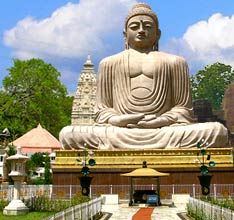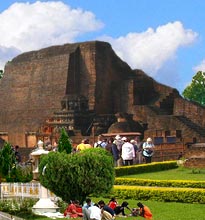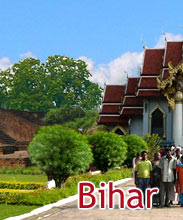 Bihar has a rich historical past. Right from the ancient history to the present century it was always a center of attention of historians. Powerful dynasty like Magadha Majanapadas, Mauryan Empire and Gupta Empire had flourished in the fertile land of Bihar. Some great name of Indian History like Ashok, Chandragupta Mauryan and the symbol of peace and non-violence Gautam Buddha had their root in Bihar. Some of the great religions of the world like Buddhism and Jainism had sprouted form here. Thus naturally Bihar is rich with varied arts and crafts. Throughout the generation the rich heritage of art and crafts has been preserved though there are slight variations due to introduction of modern technologies.
Bihar has a rich historical past. Right from the ancient history to the present century it was always a center of attention of historians. Powerful dynasty like Magadha Majanapadas, Mauryan Empire and Gupta Empire had flourished in the fertile land of Bihar. Some great name of Indian History like Ashok, Chandragupta Mauryan and the symbol of peace and non-violence Gautam Buddha had their root in Bihar. Some of the great religions of the world like Buddhism and Jainism had sprouted form here. Thus naturally Bihar is rich with varied arts and crafts. Throughout the generation the rich heritage of art and crafts has been preserved though there are slight variations due to introduction of modern technologies. The unique features of art and crafts in Bihar are the intrinsic beauties and great creativeness. These creative beauties have been preserved in various forms like in ancient stone, wooden structures, grass-clothes, lacquer and metal-wares. Bihar's craftsmen have excelled in manufacturing artistic goods which have great demands in local and international market. The fine skill and perfection of Bihari craftsmen is clearly manifested from various archeological excavations in Kumhrar, Bulandibagh, Nalanda and other places. Pottery, wooden articles, metal wares, stone wares, jewelry, lacquer works, kashida, sikki and moonj wares, wooden and clay toys, zari, artistic textile fabrics and printing on cloth are some of the contemporary crafts of Bihar which are known in Indian as well as international markets for their artistic beauties and innovations. Another chief feature of Biharís handicraft is their practicality and usefulness in everyday life like bangle making, khatwa works and stone works. However reasonable price the most important feature of the art and crafts in Bihar because of which there are in great demands in Indian as well as in foreign markets.
Madhubani Painting
Madhubani paintings as the name says get its name from Mithila region of Bihar where it is widely practised particularly by women. The history of Madhubani paintings goes back to the time of Ramayana. Originally the painting was done on freshly plastered mud wall of huts, but now it is also done on cloth, hand-made paper and canvas. Madhubani painting mostly depict nature and Hindu religious figures and the themes generally associated with Hindu deities, Natural objects like sun, moon, and religious plants like tulsi.
Rock Paintings
Rock paintings are a particular form of paintings done on the walls and ceilings of the cave shelter of ancient man. These paintings were the reflections of their social, cultural, religious and economic life. His main object of drawing were objects of nature like sun, moon, stars, animals, birds, plants, trees and rivers etc. Besides he used to draw several activities of everyday life like hunting, running, dancing and walking. These paintings were engraved on the walls and ceilings of the rock shelters with the help of some sharp objects like rock or metal pieces. Thereafter various indigenous colours like colours extracted form leaves of trees are applied on it.
Paintings
Paintings are the reflections of various aspects of human life. It is the artistic manifestation of his social, cultural, religious and economic life. The ancient men generally drew paintings about the various event of his daily life. Indians knew the art of painting since prehistoric times. Caves of Bhimabetka and Ajanta are the milestones which Indian Painting's heritage. He uses to draw pictures of natural phenomena, trees, animals, birds, rivers, his religious beliefs and economic activities. Painting in India has come a long way since then, and today represents the influences it drew from a blend of tradition and styles like Greeco-Roman style, Persian style, Mughal style and British style.
Wooden Work
From time immemorial Bihar had a history of wooden craft which consist of manufacturing of wooden furniture and toys. Right from the time of Mauryan and most particularly form the time of Ashok it has remained high on scale in terms of artistic beauties, creativity, durability and cheap price. During Ashokís reign beautiful royal throne, royal gates or doors and panels of temples were manufactured by wood artists of Bihar. This ancient and rich tradition of wood work has now converted into a big industries because of their huge demands in Indian and international markets. Patna is a very famous centre of wooden toy making. Similarly Danapur is also quite known for wooden furniture manufacturing.
Wood Carvings
Wood craving as a form of art and craft was very famous during Mauryan times. During such period wooden houses were made by carving out of wood. This ancient art has not only been preserved but also has been converted into a means of livelihood by artists of Bihar which in one of the few places where wood carving work is still practiced. Bihar is one of the few places where The wood carving and inlay work is done with wall plaques, table tops, pens and paper cutters being from wood and inlaid with diverse materials ranging from metal, ivory, stag horn to chips of different wood. Presently Patna is well known for manufacturing of craved doors and windows.
Pottery Works
Pottery is made on clay. Bihar had a rich history of clay pottery work. Since the time of Mauryan and Gupta this art has been in practice in Bihar. The archeological excavations at places like Nalanda and Rajgir had confirmed the existence of this artistic craft in Bihar. Beautiful earthen utensils and tiles are made by potters of Bihar. They have the abilities and skill to do artistic and beautiful paintings on earthen pots. Patna is very famous for such work. Patna is also famous for making earthen statutes of various gods and goddess.
Bamboo Work
Bamboo work has been remained a culture of Bihar throughout the ages and time. Right form the pre-historic time forest dwelling tribes are experts in bamboo and cane work. They used to make many utility items like baskets, household wares, woven mats, furniture and cane products like cane furniture and other decorative objects. By utilizing their skill and techniques they turned these lifeless bamboo and cane into living object which are of great value in every day life.
Sikki Works
Sikki is a grass or a weed thrived on most of the river bank. Sikki work is a craft whereby the craftsmen turned these once unnecessary riverside weed into beautiful decorative objects. This craft is particularly practiced by women artisan in Bihar. Beautiful toys and wares are manufactured out of this grass. After collecting and drying they stitch these grasses into various shapes like elephant, bird, snake and tortoise. They then put various dazzling colours on these toys to make it more attractive.
Brass Works
The brass work of Bihar is a continuation of the brass craft dome in pre-historic ages. But this form of art was at its peak during Mauryan and again during Gupta and Pala period. It has been confirmed from many archeological excavation sites like Nalanda and Rajgir. Even now artists of Bihar are very skillful in making images of god/goddesses, utensils, iron pitchers and other household utility articles with great fineness.
Tikuli Works
Tikuli is a form of craft made from broken glass. The craftsmen first melt the broken glass and then give is shape and design. Patna and Harihans cities are very famous for manufacturing of this craft. The chief markets of Tikuli are Banaras, Patna and Calcutta.
Zari Works
Artistic embroidery and Zari works is very famous in Bihar and is also a livelihood business for many families. Some of the finest Zari works can be found in shamiyanas, kanath, chandwas, pillow-covers, batwas, covers for musical instruments, tablecloth, window curtains, blouse pieces, sari, borders, etc. Patna is very famous for Zari and embroidery works.
Kasida Work
The Kasida embroidery work is a very ancient form of art. Kasida embroidery is done with gold and silver metallic threads beads, silk, and sequins on satin or velvet having the motifs of birds, leaf and many other. Kasida embroidery with geometrical patterns is very famous in Bihar. Patna is a known center of such type of Kasida embroidery.
Textile Printing
Textile printing is as ancient in Bihar as other form of art and crafts. Particularly Patna is very famous for this art which is specialized for making chunris having motifs like, parrots, peacocks elephants, mangoes, conches, fish and various deities.
Jewelry
Silver and gold jewellery making is really associated with the history of Bihar which was cornerstone of Indian history particularly during the ancient times. Therefore silver and gold Jewellery works are very special in Bihar. Goldsmiths of Bihar are very famous for making beautiful and artistic ornaments of gold and silver. Particularly the craving or kundan work on silver Jewellery is highly praiseworthy because it requires high degree of skill and concentration.
Patna Kalam
Many Indian schools of paintings were flourished afterwards and they were heavily influenced by Mughal paintings. One among these was Patna School of Painting or Patna Kalam or Company painting. As we go back to history Patna Kalam was an offshoot of Mughal painting flourished during early 18th to mid 20th century in Bihar. Although they followed the basic features of Mughal painting their subject matter was different. Unlike Mughal painting whose subjects were mainly royalty and court scenes, painters of Patna Kalam were deeply influenced by daily life of common people. Their main subjects were bazaar scenes, local rulers, local festival and ceremonies.
Lacquer Works
Bihar has a rich past of highly artistic and beautiful lacquer ware craft. Biharís lacquer ware artisans are very famous for decorating various items beautifully with lacquer ware work like legs of beds, boxes, bangles and stools. Muzaffarpur, Darbhanga and Madhubani are famous for the lacquer-work, especially for production of lac-bangles.










